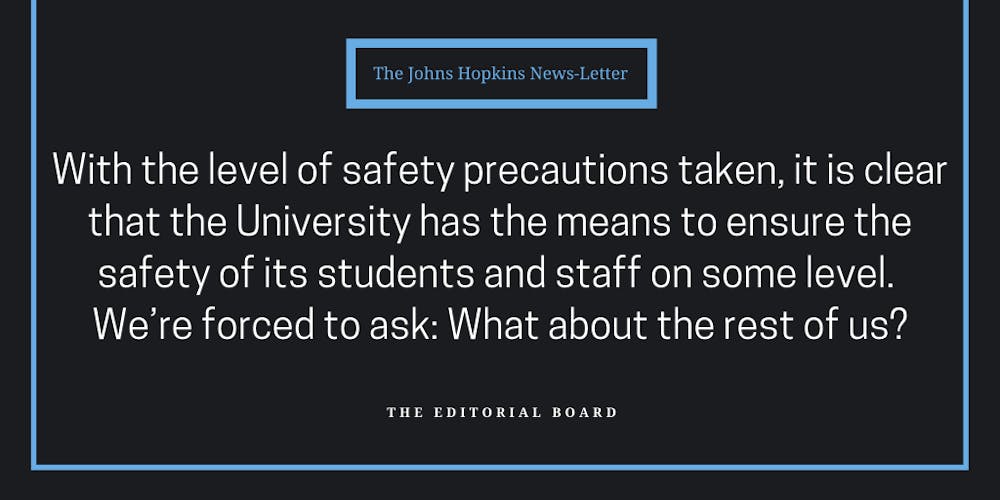Eight days before classes even started, the University announced that a small cluster of off-campus students in Baltimore had tested positive for coronavirus (COVID-19). In the same email, administrators urged students to stay at home, as they did in their delayed decision to switch from hybrid learning to online-only.
It was unrealistic for administrators to expect all students to remain at home. We are stuck in leases that the University encouraged us to sign. Students had to decide whether it was safer to return to campus rather than live with at-risk family members. International students had to choose between moving back to Baltimore and facing unreasonable time zone differences.
However, Hopkins made an exception for students who have a demonstrated hardship due to their situation at home or educational needs. These students are now being housed on-campus.
We applaud Hopkins for acknowledging that staying home is not a realistic option for everyone. Unlike other universities, Hopkins is providing each student in residential housing with a private suite. Students have both kitchens in their dorms and a required meal plan; they are not subject to receiving unsatisfactory meals at their doors, as were students at New York University.
Students were tested on arrival, and will be tested twice a week throughout the semester. With the level of safety precautions taken, it is clear that the University has the means to ensure the safety of its students and staff on some level.
We’re forced to ask: What about the rest of us?
Resources available to students living off campus in Baltimore remain limited and in some cases unclear. Students received an email on August 26 advertising the availability of free wellness kits for those located in Baltimore. While we appreciate the University providing students with face coverings, hand sanitizer, disinfecting wipes and a thermometer, these are the bare necessities for survival during a pandemic.
The merit of the few platforms advertised to students is questionable. Prodensity requires students to complete health checks twice a day to go on campus, but this application is not being enforced. Why would it be? Undergraduate students aren’t entering buildings on campus, thus Prodensity serves no purpose.
On August 25, Vice Provost and Chief Risk and Compliance Officer Jonathan Links stated that the University would start using a virtual dashboard to release specific information about Hopkins-related COVID-19 cases. Where is this dashboard, which was supposed to go live on August 31? For several months, Hopkins has made a name for itself as a leading public health institution by tracing COVID-19 cases across the globe, yet it can’t seem to do the same for its own students, staff and faculty.
It has been left up to the students to create a contact tracing Facebook page. Users self-report their test results, but without the resources to ensure confidentiality, it’s hard to expect students to self-report a positive case. For students who have tested negative, the spreadsheet at best promotes an inflated sense of superiority and at a worst a false sense of security. Indeed, many students have observed individuals without masks and gatherings larger than the 10-person limit on and near campus.
What perhaps concerns us most is that Hopkins is not currently providing COVID-19 testing to all students living off campus. According to the University’s plans, “Students who chose to live in Baltimore but are having a completely on-line experience will not receive screening tests unless they have symptoms and meet the Johns Hopkins COVID-19 Call Center guidelines for testing.”
With the University’s many public health and medical resources, it would certainly be capable of establishing a testing site on campus. For example, Georgetown University has made arrangements to provide testing to students living on or near campus, as well as options for testing at-home.
Additionally, HelWell has directed students living off-campus to arrange their own transportation for testing at local sites if they are asymptomatic. Knowing that many students lack their own vehicles and instead use public transit, the University should provide a service connecting students to testing if it will not offer them.
While we hope the University takes steps to expand services and support for off-campus students, we must also do our part as students and as residents of our larger community. Students’ reckless behavior will directly impact Baltimore, a predominantly Black city that, due to structural racism, has communities at a higher risk for COVID-19 complications and death. And as Baltimore loosens restrictions, we must be even more vigilant.
Wear a mask properly. Practice social distancing. Avoid large gatherings. Respect your friends and roommates when they inevitably have different comfort levels from you.
COVID-19 is unpredictable, but if we want any chance of being back for some form of in-person operations, we must do the right thing. It is our responsibility to adhere to public health guidelines. But it is also the University’s responsibility — given that so many of us are in Baltimore because of its recurring inability to communicate — to provide adequate testing and facilitate our safety.





